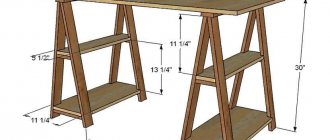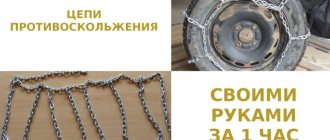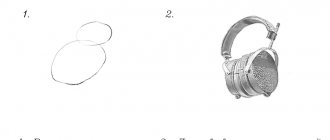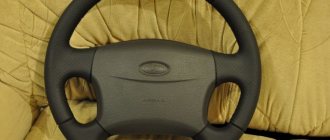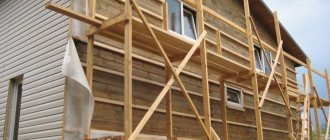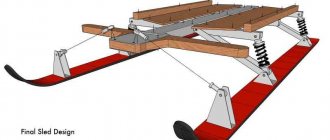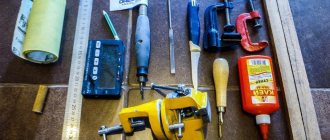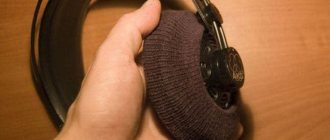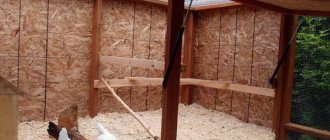From this master class you will learn how you can independently make the now popular folding pair of trestles for a portable workshop.
The design is quite simple, made from inexpensive materials. All necessary drawings are presented for manufacturing, as well as a cutting blank in the Sketchup program.
At the end of the work the author also talks about that. how to make simple mounts for hanging sawhorses on the wall from
- Materials and tools
- Drawings for manufacturing
- Making goats
- Tests
- Making fasteners for hanging
- Storage
Do-it-yourself production budget
For trestles with a height of 0.8 m, the following dimensions are valid:
- legs (4 pcs.) – 0.95 m
- top crossbar – 0.9 m
- spacers (3 pcs.) – 0.85 m, 0.77 m and 0.7 m
Therefore, to manufacture two sets of devices you will need lumber and fasteners in the following quantities:
- board 95 x 45 mm – 5 pieces 2 m each
- board 90 x 20 mm – 1 piece 2 m
- board 90 x20 – 1 piece 3 m
- furniture bolt M10 x 100 with nut – 4 pieces
- M10 washers – 12 pieces
- self-tapping screws 4 x 45 – 50 pieces (for wood)
- belt – 2 pieces
Attention: The main problem when buying boards is choosing dry wood with stable geometry. The trestles do not have a rigid frame, so “propellers”, boards with a difference in thickness, or chips are not suitable
An approximate estimate for the production of universal folding trestles is as follows:
- belt – 140 rub. (2 pieces per pack)
- bolts included – 75 RUR.
- self-tapping screws – 30 rub.
- board – 1000 rub.
You can meet the amount of 1.25 thousand rubles, that is, at least four times cheaper than when buying ready-made trestles.
Metal scaffolding
Independently assembling metal scaffolding will require performing actions similar to the previous section. Only the type of material and the type of tools with which the work is done will change. You will also need appropriate adapters to connect the tiers and a welding machine.
Before assembling metal scaffolding, you need to prepare the necessary materials:
- A rack pipe with a cross-section of at least 30x30 mm.
- Thin-walled tie pipe with a diameter of 20 mm.
- A support pipe with a cross-section of at least 25x25 mm (for adapters and bearings).
The manufacture of railings is possible from any pipe product. You should also use thin metal plates (up to 4 mm) under the thrust bearings.
All connecting nodes of jumpers and ties will require a large amount of fasteners (bolts and nuts).
Option drawing for creating metal scaffolding with your own hands Source ins05.ru
Assembly sequence
There are no significant differences in how to make scaffolding, from wood or metal. The sequence is identical. Most often, small crews prefer frame types of scaffolding. Their assembly is described below.
Making spacers
The screed pipe is cut into blanks: for horizontal struts - 96 cm, for diagonal struts - 2 m. Then cuts of 6 cm are made at the ends of the blanks and the edges of the tubes are flattened.
Making adapters
They are necessary for directly connecting pipes to increase the size of scaffolding. The 25x25 mm corrugated pipe needs to be sawn into 30 cm sections. Then the 30x30 mm corrugated pipe is sawn into 8 cm sections. After that, short blanks are welded on the edges of the long blanks.
Assembling the frame
Rack profile pipes are connected to each other by horizontal spacers, which are additionally welded every 30 or 40 cm to increase the reliability of the structure. The result will be a frame that looks like a wide staircase. Then the steps are repeated, and the second frame is assembled. It is necessary to weld 7x7 cm metal plates under the lower ends of the racks to prevent the structure from falling into the ground.
Types and components of metal scaffolding
When building a house from stone or building blocks, metal scaffolding is more suitable. They are able to withstand any load. They are less popular only for the reason that in many regions wood is still the cheapest type of building materials. The second point, which is often decisive, is that after dismantling the wooden scaffolding, the boards can be put to work - used in further construction. And metal parts should gather dust in the shed.
But metal scaffolding also has its advantages. When disassembled, they do not take up much space. Owners of wooden houses still have to use them periodically: the log house requires maintenance, so scaffolding is needed every two to three years. In this case, it is more practical to use metal rather than wooden ones. They are easier to assemble, more durable and stronger.
All metal scaffolding has the same shape - vertical posts connected by crossbars and slopes. The only difference is the way the parts are attached to each other:
Pin scaffolding. They are called so because the crossbars and posts are connected using pins. Pieces of pipe or perforated disks are welded on the racks, and bent pins are on the crossbars. This system is very easy to assemble and can withstand heavy loads. Pin scaffolding for buildings of simple shape is very easy to implement; going around bay windows and projections is much more difficult. The principle of connecting pin scaffolds Clamps. For racks and crossbars, round pipes are used, which are fastened together using specially designed clamps. The system turns out to be very mobile and movable; you can easily get around any curved facades. The downside is the limited load capacity and height (according to GOST - no higher than 40 meters). Clamp scaffolding - quick installation/dismantling Frame scaffolding. Frames of the same size are welded from a round or rectangular pipe. They are connected to each other by transverse pipes and jibs. They have a modular structure and can be easily expanded both in height and in length. They have a certain step in length - 1.5/2/2.5/3 meters, in height one section is usually 2 meters, the standard depth is 1 m. Some frames have wheels for easier movement on a flat surface. Connection of flag-type elements - pins with a slot into which the flag is inserted are welded on the frame. Holes are made in the crossbars and slopes. The elements are put on a pin and secured with a flag. Sections are built up using connecting pipes of smaller diameter welded to the frame posts on one side
With this method, it is important to have perfectly selected pipe sizes so that there is no backlash. Frame scaffolding - the principle of fastening the crossbars and wedges. Although generally similar, the designs differ in the form of the connection
On the jays with a certain pitch (usually 2 meters), perforated discs are welded. Special cleft-mouth type locks are welded onto the jumpers at both ends. The locks are fixed to the disk using a specially shaped wedge. Such scaffolding connects and disconnects quickly, has high mobility, and can be used on facades of complex shapes. Wedge scaffolding racks and crossbars are connected using wedges and specially shaped locks
When making metal scaffolding yourself, pin scaffolding is most often used. They are the easiest to implement, however, they are only good on rectangular facades; to bypass more complex shapes, you have to weld additional tubes.
Tower tour
These scaffoldings can withstand a load of 200 kg/sq.m.
meter. Such structures are often used for repairing and finishing individual sections of building facades. Since it is quite expensive to build scaffolding around the entire building, and it takes a lot of time to assemble and disassemble them, a tower-tour is used.
It is a construction of their finished frames with a ladder, wheels are attached to its base. If frames with a height of over 4 meters are used, then additional spacers are attached to the frame of the first tier, and if the tiers of the tower extend to 2/3 of the maximum height, then it is attached to the wall of the building with brackets or anchors. Such tower tours can be from 4 to 21 meters high and vary in the number of tiers.
Work area
Actually, that’s why we assemble construction trestles with our own hands - a platform. Depending on the nature of the work performed, the size of the site is also selected individually. The weight that it must withstand must be no less than the weight of a person plus the load from tools and materials. In a word, 150-170 kg will be quite enough for any construction and repair work. The overall dimensions of the platform should be such that it fits into the doorways, which is no more than 70 cm, and its length should not exceed one and a half meters, otherwise it will be inconvenient to maneuver.
Consequently, to make two sawhorses, a platform and, possibly, a wall stepladder, you will need no more than 12-15 meters of edged board, and this is quite a bit to guarantee a convenient eight-legged assistant for any repair and construction.
Direct use of scaffolding
Scaffolding for construction is also classified according to lifting height indicators, which range from 30-60 m. Changes in these indicators depend on the completeness of the product, the dimensions of individual elements and the material from which they are made.
The most common are metal scaffolds. Any type of pipe product (round, rectangular or profile) can be used for the manufacture of load-bearing (supporting) parts of the structure, which adds strength to the product. There are also lightweight types of scaffolding - made of aluminum. They are easier to assemble and dismantle and at the same time quite rigid. Their significant disadvantage is their comparative high cost.
A fairly important property of any type of scaffolding is its load capacity, which depends on the type, dimensions and maximum height of the structure. If it is necessary for the scaffolding to withstand significant weight (up to 600 kg/m²), then it is better to choose the pin-type façade type, which is distinguished as the most durable. Such scaffolding will freely accommodate workers, tools and equipment, and the necessary building materials. The wedge and frame version is considered not as lifting and will be limited to the range of 200-400 kg/m².
Installation of professional scaffolding Source gridins.com
Nothing extra: mobile trash can
Forgive me for such a natural comparison, but do you know why the horses that drove chaises around the city had a bag tied under their tails? Yes, precisely for this reason, to keep the pavement clean. So my working goat got such a device.
I cut the rim off the paint bucket and cut off the lid. You can attach a garbage bag between the rim and the lid. And the rim itself was fixed with a movable holder
I hope you liked my construction beast. I will be glad if my experience helps someone with repairs
Thank you, Olga! A charming master class from a real craftswoman! It's nice to look at your work. We don't even have anything to add. The only thing you can do is to suggest complicating the task, as in this short video on creating a multifunctional carpentry table:
Watch this video on YouTube
We are waiting for your impressions and comments, as well as new materials in the section “This is not a woman’s business!”
PHOTO: Olga Yarovaya
Start of work: preparation of material
It is more convenient to cut the plywood on a circular saw. If you don’t have one at hand, you can use a hand saw, but in this case the work will be very labor-intensive and time-consuming. A regular electric jigsaw with a suitable blade can also help here.
PHOTO: YouTube.com Plywood scraps are unraveled to the specified size
Dissolving scraps to the desired width
After the plywood scraps are cut to the required length, you need to cut them to width. After all, too wide elements are completely useless here. It's just extra weight. As for strength, when the trestles are assembled, they will be able to withstand more than 100 kg each.
Particular attention should be paid to safety precautions when working with a circular saw. Do not bring your hands too close to the rotating disk
If you need to push the part, it is best to use any piece of board or stick.
PHOTO: YouTube.com When the parts are adjusted to the desired width, you can begin assembly
Complete assembly of goats: what material is required
In order for the trestles to be foldable, each of them will require two door canopies, which will connect the elements. To complete this work, you need to lay the squares one next to the other on any flat surface. They should be located in one line at the ends. If there is no suitable workbench, then all the work can be done on the floor.
At first glance, it may seem that the structure made from scraps of plywood looks flimsy, but this impression is deceptive. After complete assembly, the strength will be at a very high level.
PHOTO: YouTube.comThe elements are located as needed, it’s time to connect them together
Door awning fastening
The canopies are attached to the same self-tapping screws with a slight indentation from the edge of the elements, but without going beyond the joint of the plywood scraps. It is better to purchase canopies with three or even four holes for fixing screws. This will give the structure additional strength.
It is best to use hardened black self-tapping screws (they are also called German, or Germanic). The main thing is to choose the right length so that they can sink into the wood to a depth sufficient for fixation (through both layers), but at the same time do not stick out too much from the back side. Otherwise there is a risk of injury.
PHOTO: YouTube.com Trying on door canopies before final fixation
The final touch in the manufacture of construction sawhorses
Despite the fact that after fastening the canopies, the sawhorses seem ready, they lack stability. If you press from above, the legs will simply move apart in different directions. This means a little modification is needed.
To prevent falls from the scaffolding, it is necessary to install a limiter that will hold the legs in the desired position. A wide and durable canvas belt is ideal for this. Having measured the required length (the same for both trestles), it needs to be fixed on the lower jumpers of the elements. However, simply screwed in screws will not work here. The connection needs to be strengthened. This can be done using a metal profile through which the screws will be screwed.
PHOTO: YouTube.com The canvas belt will perfectly hold the sawhorses in the desired position
About choosing fasteners
As for fasteners, they are usually faced with a dilemma - nails or self-tapping screws. For the construction of wooden scaffolding, the best option would still be to use ordinary (smooth-bodied) nails. They are made of “mild” low-carbon steel, due to which they better withstand static and variable loads, which especially often occur on scaffolding. To put it simply, they may bend, but not break.
Self-tapping screws are more convenient. At least from a practicality point of view. They significantly speed up the assembly of the structure, they make it easier to accurately position the fixed parts, while they provide the same quick and easy dismantling of the structure (with minimal damage to the lumber). But given the fact that self-tapping screws are made of hardened steel, and their working fluid has a relatively small diameter, such fasteners are less resistant to shock or variable loads and often break.
To a greater extent, this problem is characteristic of oxidized screws (black) and to a lesser extent – anodized (yellow and white).
When making homemade scaffolding, as a compromise, you can use both types of fasteners: loaded nodes can be fastened with nails, and less critical ones with self-tapping screws. The length of the nails for loaded scaffolding elements is selected in such a way that when hammered, their ends protrude by 2-3 cm. After this, they are bent across the fibers and sunk into the wood.
Storage and use of sawhorses
Using our recommendations on how to make a sawhorse, you will create a stable structure, and cutting firewood on it will be a pleasure. You can also view ready-made sketches, photo and video materials on the Internet.
Equally important is the correct use of sawhorses. You should not load too massive and heavy logs on it.
The folding design of the sawhorses is suitable for cutting firewood using a hand saw or chainsaw. This device is simply indispensable in the homestead for collecting firewood and stove logs to light the stove, barbecue or fireplace in the house.
Drawings for manufacturing
Schematic drawing
Dimensions of trestles
- height 811 mm;
- width of the upper base 844 mm;
- minimum width (legs) 711 mm.
Goat drawings in Sketchup
In case you want to change the design and dimensions at your discretion, you can download the file for editing in SketchUp
Download file: scetchup.zip [39.73 Kb] (downloads: 1014).zip
3 Metal sawhorses for cutting wood
Metal products are compact in size, have a long service life, and are highly reliable. Small specimens intended for processing small volumes of wood, and larger machines for large-scale production are made from this material. The cost of a homemade model using scrap metal waste is low. To make them at home, you need to prepare the following materials and tools:
- profile corner 50x50 mm, pipe of similar characteristics;
- grinder, hacksaw;
- measuring tape;
- chalk;
- connecting bolts, welding machine.
A sketch is drawn up listing the main elements and the mandatory marking of each of them. The design of the upcoming product may be different, but in order to give greater durability, two additional profile elements at an angle or a transverse beam of the base are additionally installed. For example, from a piece of pipe. In the second case, it is necessary to protect the saw teeth from contact with the beam, so at the final stage of assembly, a piece of timber is secured on top.
The fastening points are marked by welding or bolts. If a bolted connection is provided, then additionally indicate the location of the holes. A system assembled by welding is one-piece; a dismountable system is more mobile.
All parts are cut according to the intended dimensions using welding or a grinder. To prevent sliding and turning of the logs while sawing, a jagged edge is prepared on the inner side of the outer legs. For the safety of further work, the cut sites are processed, removing scale, burrs, and other defects from each edge. The product is being assembled. To protect against rust, non-demountable structures are treated with an anti-corrosion compound.
You can build a mobile version of folding trestles from metal. The simpler the design, the less often the device breaks down, so this type of machine is manufactured as simply as possible. When folded, it takes up little space, is convenient to store and transport, but more manufacturing and assembly costs are required.
The main difference is the mobility of the X-shaped support; it can be folded like scissors. The bolts are not fully tightened, to prevent them from unscrewing spontaneously, an additional lock nut is installed. Installing a limiter helps fix the supports in the desired position. This can be a metal chain attached to one leg of the support, and a hook is made on the other to hook it.
What's better?
The first question that a home owner has during construction or renovation concerns the choice of material for the structure. Of course, it’s hard to argue with the fact that metal is always a favorite. However, what is captivating about wood is its flexibility, the ability to make do with simple tools that are in any “gentleman’s kit” - a hammer, drill, saw and screwdriver.
Metal in this case is much more complex. To get the most durable structure, you need a welding machine and skills to work with it.
Such a structure will have to be stored somewhere; it will require quite a lot of space. Of course, high-quality scaffolding can be rented out, but it is unlikely that many owners will be impressed by the possibility of such income. It is for these reasons that preference is often given to traditional wood, a material that is light in every sense.
Another important point when choosing a material is economic feasibility. Many people believe that it is logical to give preference to metal only in one case: if it can be “obtained” for free. If you add to the price of hardware the cost of fastening elements, as well as welding work, then homemade scaffolding will cost more than factory scaffolding. At least purchased wooden products.
Now a few words about wood, which should not have serious defects. The ideal material is considered to be spruce boards, characterized by minimal weight and the same number of knots. However, they are not always available on the farm, which cannot be said about pine. This is a second potential candidate, but it needs to be tested first.
To test, elements 2-2.5 m long are placed on low brick pillars, then stand on the middle of the board and jump several times. If the board withstands such experiments without problems, then it can be safely used for the manufacture of scaffolding.
Mobile trestles made of wood
The design of conventional trestles has rather large dimensions and weight, which is a serious obstacle when transporting the machine. But you can also make a mobile installation with your own hands, which will be foldable and can be easily carried. But, as a rule, such plans require more costs and time to assemble.
For folding trestles you will need the following material:
- durable, but small in diameter wooden beams. You will need at least 4 units of them;
- for the base of this structure it is best to use a metal pipe with a length of 1 to 3 meters;
- since the design is folding, you will need a limiter (you can use a strong rope, a small chain, a good belt or cable);
- To connect the components you will need a wood drill. It is worth choosing the most durable option.
To avoid unnecessary costs and reduce the likelihood of device breakdown, this machine is manufactured as simply as possible. You need to start the assembly with the beams. You can make them yourself from a 50 mm board. After receiving the finished material, it is necessary to mark the location of the cut where the legs for the trestle will subsequently be installed.
After drilling a hole on each strip for the pipe, the base is inserted into them, and the legs are set in their places. Next you need to make a limiter for the racks, which will not allow the legs to move apart.
Mobile wooden sawhorses for sawing firewood
Here you should be careful, choose the same length for both sides, which will allow the sawhorses to open 350 to 450 degrees. Thus, a structure will be assembled that will be easy to fold and store in small spaces.
Goats for working with a hand saw
Most often, a regular saw is used for harvesting wood; this allows you to cut small-sized logs. Goats for such purposes may have standard dimensions. To assemble such a structure you will need the following materials:
- Beam with a section of 100 by 100 mm. This thickness of wood is enough to create a stable structure. The length of the material is taken from 1 to 1.5 meters.
- Beam for legs of smaller diameter. For supports, material from 50 to 50 m in cross section and a meter in length is suitable. The goat will have 4 legs in total.
- Material for crosses. The “horns” of the structure are made of 10 by 10 cm timber. Some structures require reinforced legs. For them, timber with a cross section of 30 by 30 mm or more is used. For stability you will need 4 supports, but you can leave only two.
- Fasteners. It is best to use self-tapping screws to connect parts. The diameter of the cap is 45 mm and the length is 100 mm. The entire product will require about 40 fasteners.
- Coating. In order for the timber to remain intact for a long time, it must be impregnated with varnish or other protective compound.
The material will be required for homeowners who do not have building materials on the site. Those who have scraps of timber or pipes left over from other work can use them in assembling the trestle.
To create the design you will need the following set of tools:
- hacksaw for cutting timber;
- corner for aligning parts of the structure;
- pencil for marking;
- hammer or screwdriver;
- roulette;
- finishing coat and brush.
Once the material has been purchased, assembly can begin. The goat frame is made starting with wood processing. To do this, use a tape measure and a pencil to mark the cutting areas. They need to be made 6 on each side. There will be 12 of all grooves for connecting the legs and crosses. With a beam cross-section of 100 mm, the depth of the groove is 25 mm, this is enough for a strong fastening. When cutting the grooves, make sure that they are a couple of millimeters smaller than the legs. After marking and making grooves, all parts are assembled into a single structure.
After assembly, fastener reinforcements are installed; they enhance the strength of the structure and make work safer. To do this, saw off the bottom of each leg so that there is enough space to install a new fastener. After assembling the product, it is treated with a protective compound. To do this, use varnish or stain. When the structure is dry, it can be used.
Leg assembly and fitting
The performance of the device depends on the quality of the marking of the hole for the bolt. Therefore, preliminary fitting using technology is necessary:
- the leg is placed on the table so that the cutout hangs over the tabletop (you can use a stool, chair)
- the support bar (upper) is installed vertically in the groove
- a second leg is added on top of the first (the bar should fit snugly into the cutouts in both parts)
- the structure is temporarily tightened with a clamp
Then the following operations are performed:
- Using a vertical square, the intersection of the legs is transferred to the side surface on both sides of the structure
- the resulting points are connected by a line, which becomes the vertical axis of rotation
- the longitudinal axis of the leg is marked with a square
- at the intersection of these lines there will be a center for the hole of the M10 bolt, which is the hinge of the connection
Attention: The holes must be perpendicular to the plane of the boards, so a jig is required. They can serve as a cut in a block pressed to the leg with a self-tapping screw or clamp
If the hole is inclined, the legs will not be able to transform into the working position.
The legs are assembled in stages:
- the bolt goes through one piece
- two washers are put on it to facilitate the rotation of the wooden elements relative to each other
- the second leg is put on the threaded part
- the hinge joint is secured with a nut
The result is a set of two legs, into the cuts of which a support bar is easily inserted from above.
Design and use cases
Unlike classic trestles, universal trestles are folding, which makes storage and transportation easier. The design of the carpentry and construction device is as follows:
- legs with spacers, hingedly connected to each other
- removable support bar
- belt tie at the bottom
The device allows you to harvest firewood, cut long lumber and support scaffolding panels (you will need 2 pairs of trestles) by default. A wooden table top can be attached to the support crossbar to accommodate power tools (for example, a cross-cut machine, a drilling machine, a sharpening machine).
If you assemble a lightweight frame from boards or plywood, you can build a large-sized carpentry table-workbench from two trestles for assembling furniture.
Cutouts in the support strip allow you to work with tubular workpieces and press the lamellas of the joinery parts being glued together. On one side of the trestles you can attach a sheet of plywood, gypsum board, OSB for marking, straight or figured cut.
Assemble the frames
1. To make half-wood joints, install a 19 mm thick groove disk into the saw machine and make test joints on scraps with a cross-section of 19 × 114 mm, setting the sawing depth equal to half the thickness of the workpiece. Cut cutouts in legs A and crossbars B for half-tree joints (Fig. 1 and 2).
2. Glue the A/B leg frames together and secure them with clamps. When installing clamps at half-wood joints, in order to evenly distribute the pressure over the entire gluing area, place wooden scraps under the jaws of the clamps. Check the squareness of the assembled frames.
3. Create a 15° bevel on the top edge of each A/B frame (Photo A).
Set up a circular saw to cut the bevels at 15°, attach a flat board to the A/B leg frame, and cut a bevel on the top edge of the frame.
Photo instructions
We invite you to view a number of photographs on the topic of how to make wooden scaffolding yourself:
Blanks Assembling the frame Holes for fastenings
Bolted connection
Installing the frame Fixing the diagonals
Extension Flooring
Assembly diagram
- Place two more boards in the shape of a rectangle on the inverted structure and connect them. It turns out to be flooring or an area for work.
- Take four more wooden panels with dimensions 1100x100x30 and attach them at the ends. The result is a structure somewhat reminiscent of a table.
- The next step is to strengthen the structure with boards 1700x100x30mm and 1500x50x30mm. They must be attached so that the opposite reinforcements are in different diagonals.
- And the last point is attaching the ladder. For more convenient operation, the steps at the bottom can be made with a small protrusion. You select the length of the stairs based on individual preferences.
- That's it, your goats are ready. But for safe construction and repair work they need to be checked. To do this, we place any objects with a large weight on the surface; if the trestles can withstand it, then you can not be afraid and safely use them in installation.
The process of assembling scaffolds
- To install lightweight wooden scaffolding with your own hands, you will need the same set of tools. We will use beams 5x15 cm and boards 3-4 cm thick as materials. We fasten all elements with nails. If necessary, the scaffolding reaches the third floor, but it will not be possible to create a second tier. They do not need a flat, dry area, since the main part of the structure is in a “suspended state.”
- We knock together supports from two elements 1 m long. To do this, we place them at right angles, fix them and mount them on the wall. The vertical one is directed downward, the horizontal one is directed to the side. Together they form the base for the decking. They are placed in increments of 1-2 m. Jib beams are inserted into the corner - diagonal beams, the bottom side resting on the ground. The bottom is fixed by driving a stake into the ground, the top is nailed down or tied with wire.
- The space between the sides of the corner is boarded up with shields on both sides. They serve as stiffening ribs and additional fastening for the diagonal holder. A shield is placed on top.
One section can support a person's weight. To prevent the racks from moving to the side, install side holders or nail the diagonals together with additional jumpers. One way is to hang the base with long anchors that can support heavy loads. It is possible that the holes from them will have to be sealed with cement mortar.
Drawing of construction trestles. DIY installation
When carrying out any work related to repairs or maintenance of the house, it is required to rise to a certain height. If you can screw in a light bulb with a chair, and cover a small crack with a stepladder, then extensive work requires greater mobility.
To move at height, construction trestles, otherwise called scaffolds, are created. Ready-made structures are available in construction stores, but prices run into thousands of rubles. It’s easier to make them yourself, and it costs several times less.
Construction trestle structure
Before you start making construction trestles with your own hands, we select materials for production. There are three main materials from which goats are made:
- metal;
- tree;
- wood-metal combination.
Since metal ones are difficult to create and quite expensive in terms of materials, let’s consider wooden trestles.
After choosing a material, it is worth understanding the conditions of their use. If these are stationary or rarely moved scaffolds, then it is worth creating a disposable scaffold. If you plan to move the trestles frequently, we choose folding trestles.
Before starting carpentry work, we create a drawing and calculate the required height. The standard height for comfortable work for an adult man is 80–90 cm.
For a finished product with a height of 85 cm, legs 95 cm long are needed.
The length must be chosen such that when a construction site board is placed on top, the beam protrudes at least 5–7 cm on each side, but it is better to take it with a margin.
The design is extremely simple, when open it resembles the letter “A”, and can be used both at a low height and with the help of two trestles at full height.
Preparation
After creating the drawing, you need to decide how long the platform will be, and how many trestles will have to be made for it. Goats are always created from two or more - if the board being applied is long and can break in the middle.
Collapsible wooden construction trestles
The advantage of collapsible trestles over a conventional platform is their reusability and the ability to quickly remove them from storage and use. In conventional scaffold construction, only boards fastened with nails are used.
After completion of work, it is difficult to leave them for storage unassembled. To ensure that such scaffolds do not take up much space, they have to be dismantled, which is difficult if they are made with high quality.
Collapsible trestles do not take up much space; they can be transported and used for various needs other than their intended purpose. To create a sawhorse, you need two supports.
To make one support you will need:
- four boards for legs - 0.95 m;
- board 0.9 m for the top;
- three crossbars of 0.85, 0.77, 0.7 m each.
Carpentry work
The goats are assembled in accordance with the recommended instructions.
- Make markings on the legs, cut off excess wood on both sides at an angle of 800. The cuts should be parallel.
- Use the finished leg as an example and make the rest.
- Check that the ends of the top board, which will support the platform, are at an angle of 900.
- On the boards of future spacers, measure an angle of 800 at one end and 1000 at the other. Cut.
- The blanks are ready, now the space for the top board is cut. To do this, fold the two finished legs into the position that they will take when open, draw an angle of 900, and cut. All the others cut through this leg.
- The legs are connected like scissors, a rotation axis is drilled into them, in which the bolts are not fully tightened, allowing the legs to open and close.
- All that remains is to make spacers between the finished legs, two on the wide side and one on the narrow side. Then fasten the tension belt to the lower spacers.
- One support of the future construction site is ready, the second one is being assembled according to the same scheme.
Collapsible trestles are an easy and inexpensive way to create a construction site that is durable, mobile, and able to support the weight of an adult man, as well as building materials.
Images from www.forumhouse.ru were used for this material.
Calculations and materials
You can buy sawhorses, both folding and regular, in almost any specialized store. But they most often have an aluminum base and are quite expensive. It is much easier and cheaper to make trestles for your dacha with your own hands. This is a relatively simple design that requires a minimum of carpentry skills from the manufacturer. In addition, homemade goats will not cost you a pretty penny, they can be easily adapted to the construction project you need, and they can also be easily used in the future if desired.
Goats from the store
You can assemble both metal and wooden trestles yourself. But we still recommend choosing the wooden version. Wood is much easier to work with and cheaper.
One of the first stages of work is the design and creation of a drawing. We strongly recommend that you do not carry out all the work “by eye” - it is very easy to make a mistake due to which your structure will turn out to be crooked and unstable. Well, or it won't work at all. Therefore, sketch out a detailed drawing on a piece of paper indicating all dimensions, immediately write down how much fasteners you need and how much base material you need. The drawing will also clearly allow you to see what the finished structure will look like.
A simple drawing of a folding trestle
At the first stage, it is important to determine the height of the future goats. Usually it is chosen depending on the person’s height
Traditionally, the height varies between 75-95 cm.
Your favorite desktop or workbench will also help you determine the height. If you have one and you often work with it and feel comfortable, then you can measure its height and make a sawhorse with exactly the same parameters.
Universal sawhorses
The support legs of a goat must be assembled at a certain angle relative to each other. This will increase the stability of the structure. Let's take the standard version with angles of 65 and 80 degrees. Based on the height and angles of the legs, it is already possible to calculate the parameters of the remaining parts. Thus, it turns out that for one goat you will need:
- legs 95 cm long - 4 pcs;
- upper support crossbar 90 cm - 1 piece;
- spacers - 2 on each side.
In addition, do not forget to buy fasteners. These are bolts, nuts, washers and screws. These elements will allow you to assemble a reliable structure. We do not recommend using nails - connections with them are less reliable and durable than with self-tapping screws. Nuts and bolts will be needed to connect the folding legs.
You can buy wood for the goats at your nearest hardware store, but you can also look at all sorts of scraps at your dacha. You most likely have them if you have done any construction work before. The board is suitable size 100x30 mm.
Do not use wood with obvious defects to create a goat.
Other goat options
The most widely used for sawing single thick logs with chain saws are various sawhorse designs with fixation of the rear part of the log.
These are the ones that are produced most industrially, besides the cruciform ones.
Their designs are so simple that they do not need detailed descriptions; everything can be seen in the photo. Such sawhorses for sawing firewood can be made by any home craftsman who is more or less able to hold a tool in his hands. The main thing here is the ability to balance the dimensions of the support platform with the size and weight of the logs being cut. It may not have a rectangular shape, or even be completely replaced by stops. I liked this goat design for its simplicity and minimalism.
Or this option, designed for very thick, but not long logs:
And finally, we will present a wooden structure that is very successful for home production, which is also guaranteed to ensure that the saw does not jam due to the small width between the saw stops at the cutting site.
In such sawhorses, the log is laid with equal overhang on the sides for stability, and is sawn in the middle. Next, do the same with the resulting pieces.
In all cases, when making a trestle yourself, you choose the height individually, so that, first of all, it is convenient for you.
Dear readers, if you have any questions, please ask them using the form below. We will be glad to communicate with you;)
Do-it-yourself sawhorses for cutting wood? Easily! Good owners make sure in advance that they have enough firewood in stock for the winter. To prepare them, you must have an indispensable tool for all owners of private houses - a sawhorse for sawing firewood.
This is a fairly simple design that everyone should have in their dacha to make it convenient to process, prepare firewood and saw metal strips or wooden boards with millimeter precision.
Making goats with your own hands is quite simple, and even someone who does not have any special skills can handle it.
Kinds
To make a classic version of such cutting equipment, you will need any of the following materials:
Despite the fact that the design itself is simple, sawing sawhorses can be classified as machines. For this reason, during production, certain conventions must be observed, one of which is the presence of a drawing or plan according to which the assembly will be carried out. When planning, it is worth signing all the dimensions; this also applies to even the smallest details.
Criterias of choice
The main thing to pay attention to when assembling is the dimensions. This will be affected by:. All the time spent on work will depend on what sizes are chosen.
The best option is to make the machine with a height of 0.9 to 1.1 m. Thus, the person who will work will not bend his back too much, and his arms will be positioned horizontally. It will be easy to work and the load on your back will be reduced
All the time spent on work will depend on what sizes are chosen. The best option is to make the machine with a height of 0.9 to 1.1 m. Thus, the person who will work will not bend his back too much, and his arms will be positioned horizontally. It will be easy to work and the strain on your back will be reduced.
Features of using tools when working on sawhorses
If you plan to process wood with a regular two-handed saw, then you will definitely need a reliable support for the second one. For this reason, when planning, take care of the presence of such elements. An affordable option is to create a support from timber, which will give you the advantage of installing a support anywhere. When using a power tool like a chainsaw, make sure there is a sturdy surface on the sawhorse.
Goats for sawing firewood with a chainsaw have their own characteristics, since there are differences in operating rules that affect the safety of the worker. In this case, you will need to take care in advance of a place for free hanging of the material that will be sawn. This way you can avoid the tool getting caught in the sawn blade.
Attached scaffolding
The design gets its name from the fact that they are simply leaned against the wall rather than secured. They are held in place by a stop. The more you load this scaffolding, the stronger it will stand. There are two types of construction, which are made in the shape of the letter “L”, but they are turned in different directions.
The first picture shows a reliable and simple scaffolding design. Their only drawback is that they cannot be adjusted in height. It will be convenient to hem the roof overhang, clean or install a drain, in general, all work that does not have a large variation in height. Some were even able to adapt such scaffolding for building a house from timber. It will be convenient to lift or roll logs along the edges of the stops. They are quite reliable, as they can support a log of 11 meters and three people in addition.
The second picture shows Armenian scaffolding or envelope scaffolding. This design is also reliable and simple, although you wouldn’t be able to tell at first glance. But still this has been tested by thousands of people who have used them in construction. This is attractive because a minimum amount of building materials is required, and assembly/disassembly/transportation can be done in a few minutes. The main thing is to make the triangles, and installation at the desired height will not take much time - raise the triangles, support them with a beam, which then needs to be fixed in the ground.
To make triangles, use a board with a thickness of 4-5 cm and a width of 10-15 cm. The vertical part can be long so that it is convenient to lift the scaffolding to the required height using it. The crossbar on top should be 0.8 to 1 meter long, and the flooring boards will be laid on it. They will also be 5 cm thick, and the wider the larger, the better, preferably 15 cm.
When making corners, position the joint so that the horizontal board is on top. To increase reliability, use metal linings in the form of a corner. But if you install the corner using three jibs nailed on both sides, this is not necessary. Triangles are installed for every meter. If it works, they are nailed to the facade, and if not, all hope is for gravity. The main load in this design goes to the thrust board, which is placed at an angle and it rests with one end on the ground and the other on the upper part of the triangle.
The stops must be made of timber or boards with a thickness of at least 5 cm, pipes of at least 7.6 cm in diameter or cross-section (for profiled pipes, at least 5*4 cm). When installing the stop, it should be placed exactly in the corner, driven into the ground, additionally secured and driven in wedges. To eliminate the risk of lateral shift, the installed stops should be secured with several jibs, which will connect everything into a rigid and strong structure. For jibs, you can use an unedged board, if you have one, the main thing is that the width and thickness parameters are not less than the minimum limit.
If you need to grow the thrust boards (so that they are more than 6 meters in length), you should make an additional stop. It will rest against the middle of the base and thereby relieve part of the load. Now about the flooring of scaffolding with your own hands. It needs to be made from a wide board with a thickness of 4-5 cm. In this case, you need to fix them to the triangles, at least with self-tapping screws. This design does not provide for the installation of railings, and the slightest vibrations under your feet will cause discomfort, so it is highly advisable to take care of fixation.
Leg assembly and fitting
The performance of the device depends on the quality of the marking of the hole for the bolt. Therefore, preliminary fitting using technology is necessary:
- the leg is placed on the table so that the cutout hangs over the tabletop (you can use a stool, chair)
- the support bar (upper) is installed vertically in the groove
- a second leg is added on top of the first (the bar should fit snugly into the cutouts in both parts)
- the structure is temporarily tightened with a clamp
Then the following operations are performed:
- Using a vertical square, the intersection of the legs is transferred to the side surface on both sides of the structure
- the resulting points are connected by a line, which becomes the vertical axis of rotation
- the longitudinal axis of the leg is marked with a square
- at the intersection of these lines there will be a center for the hole of the M10 bolt, which is the hinge of the connection
Attention: The holes must be perpendicular to the plane of the boards, so a jig is required. They can serve as a cut in a block pressed to the leg with a self-tapping screw or clamp
If the hole is inclined, the legs will not be able to transform into the working position.
The legs are assembled in stages:
- the bolt goes through one piece
- two washers are put on it to facilitate the rotation of the wooden elements relative to each other
- the second leg is put on the threaded part
- the hinge joint is secured with a nut
The result is a set of two legs, into the cuts of which a support bar is easily inserted from above.
Varieties
How to make sawhorses for firewood?
Thanks to modern capabilities and technologies, you can buy various types of scaffolding in stores. These structures can have different sizes, assembly methods, production materials, and can also be equipped with various additions. The first type is considered to be ordinary construction scaffolding. They are produced similar to stools, but using more advanced technology. This type of structure is classified as foldable, as it can be disassembled into individual elements. In this case, the largest part is considered to be the working flooring.
Modern versions of construction trestles have decking that can be installed at different heights. This became possible thanks to the features of the sidewalls, which look like stairs. Typically, these devices weigh a lot, since they are designed for the work of several people at the same time. The dimensions of this design are considerable. A professional construction trestle has the following dimensions: 150 (200) cm – width and 180 cm – height. This design option is ideal for working on large objects, but for an apartment it is considered quite cumbersome. Often the construction trestle package includes a ladder, a limiter, and wheels with stoppers.
The second type is a transformer. This is an ideal tool for indoor work and is quite compact when assembled. The main characteristics of this type of construction trestle include light weight, practicality, ease of use and transportation. Due to the design features, this option can be used not only on a perfectly flat surface, but also when inclined and even on steps. Such scaffolding is often used as an alternative to stairs.
The transforming scaffolds have a height of no more than 100 cm, a width of 50 cm. When unfolded, the dimensions are no more than 160 cm, and when folded, the goat can easily fit into a car trunk. Based on the material used, construction trestles are divided into aluminum, wooden and combined. You can also find painting scaffolds with dimensions of 50 by 100 cm on sale.
Features of manufacturing wooden scaffolding
If you decide to make trestles from wood, then the step between the racks can be equal to the limit of 2 to 2.5 meters. As for the width of the flooring, it should be equivalent to one meter. You should not make the structure too high; the maximum height limit is 6 meters. To carry out the work, it is necessary to prepare boards 50 millimeters thick. As for their width, this figure should not appear less than 100 millimeters. You can replace such blanks with a square beam of 10 cm. The racks and stops can be based on round timber. Spacers and barriers are typically made from boards that are 30 millimeters or more thick.
Design features
Different types of work will require different types of scaffolding and scaffolding. To work with light weight materials, high load-bearing capacity is not required. In this case, you can make an attached scaffold or an envelope-shaped structure. To finish the gables or just the exterior of a one-story low house, it is permissible to use construction trestles, and lay flooring on their crossbars. If you can't support anything on the walls, you can use a trestle with decking boards laid on the crossbars.
For laying brick walls or building blocks, finishing the facade with stone or brick, full-fledged scaffolding will be required. Timber scaffolding can be made more rigid by using braces and stops.
As a rule, such structures are not attached to the walls, but are fixed on stops that will support the racks. Let's talk about each type separately.
Choosing a place to build
When choosing a place to build a goat house, give preference to a small hill or plain. In the lowlands, the barn will be damp, which means the animals will constantly get sick and waste away.
Before construction, the area for construction must be cleared of vegetation: remove trees and shrubs with maximum uprooting of the root system. After preparatory work, level the area.
Keep in mind that each adult goat needs about 1 square meter. m. area, and for kids - 0.6-0.8 square meters. m. Place the building on site so that the façade and walking pen are located on the south side.
Photo
The photographs show various designs of scaffolding:
Clamp scaffolding Wedge-clamp scaffolding
Scaffolding tower Metal Mobile scaffolding
For façade finishing For painting Scaffolding during reconstruction
